TOCMS WindowsWindows 11Windows 10Windows 8.1Windows 8Windows 7VistaWindows XPWindows NTWindows Server
Windows 10 System CommandSystem Command on MS OSBCDEdit.exehelp.exeASSOCARP.exeAT.exeattrib.exebreakBootcfg.exe
BCDEdit /store, /createstore, /export, /import, /sysstore/copy, /create, /delete, /mirror/deletevalue, /set/enum, /v/bootsequence, /default, /displayorder, /timeout, /tooldisplayorder/bootems, /ems, /emssetting/bootdebug, /dbgsettings, /debug/eventsettings, /eventTOPICS, FORMATS, ID, TYPESBOOTAPP, BOOTMGR, BOOTSECTOR, CUSTOMTYPES, DEVOBJECT, FWBOOTMGR, MEMDIAG, NTLDR, OSLOADER,RESUME
Draft for Information Only
Content
BCDEdit Topics Types Apptypes
Topics of Types for Device Objects and Particular Applications
BCDEdit TYPES BOOTAPP
Syntax
TYPES BOOTAPP
Display
Debugging
Memory
Emergency Management Services
Devices and Hardware
Applications
Recovery
Verification
Error Screens
BCDEdit TYPES BOOTMGR
Syntax
TYPES BOOTMGR
Boot
Resume
Display
BCDEdit TYPES BOOTSECTOR
Syntax
TYPES BOOTSECTOR
BCDEdit TYPES CUSTOMTYPES
Syntax
TYPES CUSTOMTYPES
BCDEdit TYPES FWBOOTMGR
Syntax
TYPES FWBOOTMGR
Boot
Display
BCDEdit TYPES MEMDIAG
Syntax
TYPES MEMDIAG
Test
BCDEdit TYPES NTLDR
Syntax
TYPES NTLDR
BCDEdit TYPES OSLOADER
Syntax
TYPES OSLOADER
Boot
Display
Options
Processors and APICs
Hardware Abstraction Layer (HAL) & KERNEL
VESA, PCI, VGA, and TPM
Debugging and Performance
Memory
Drivers and System Root
Hypervisor
Virtual Secure Mode
BCDEdit TYPES RESUME
Syntax
TYPES RESUME
Display
Hibernation file
Other
Sources and References
BCDEdit Topics Types Apptypes
Topics of Types for Device Objects and Particular Applications
To display topics of types for device objects and particular applications.BCDEdit TYPES BOOTAPP
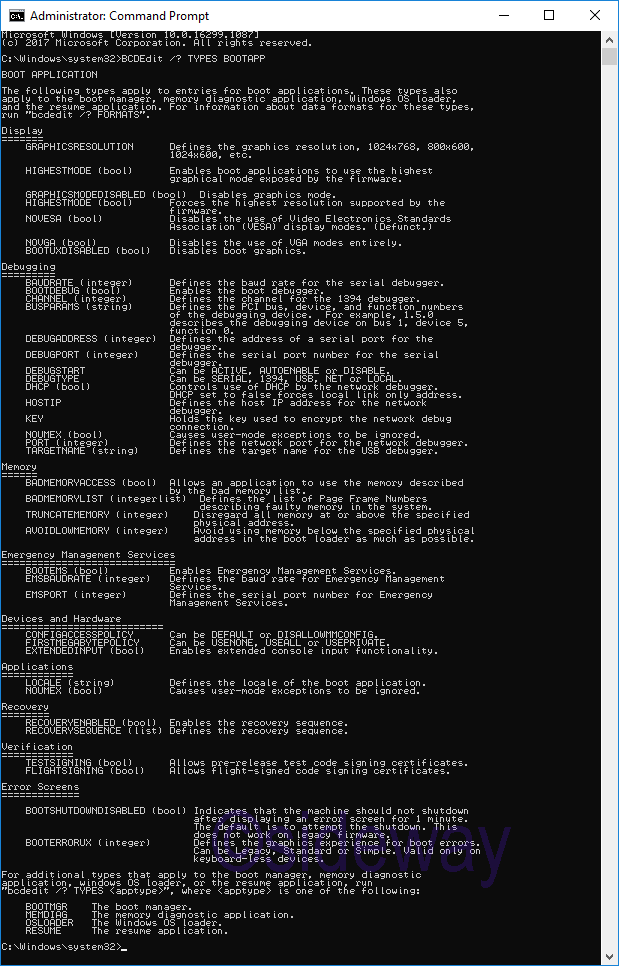 To display the list of types for boot application
To display the list of types for boot application
Syntax
bcdedit /? TYPES BOOTAPP
TYPES BOOTAPP
The following types apply to entries for boot applications. These types also apply to the boot manager, memory diagnostic application, Windows OS loader, and the resume application. For information about data formats for these types, run "bcdedit /? FORMATS".Display
GRAPHICSRESOLUTION Defines the graphics resolution, 1024x768, 800x600, 1024x600, etc. HIGHESTMODE (bool) Enables boot applications to use the highest graphical mode exposed by the firmware. GRAPHICSMODEDISABLED (bool) Disables graphics mode. HIGHESTMODE (bool) Forces the highest resolution supported by the firmware. NOVESA (bool) Disables the use of Video Electronics Standards Association (VESA) display modes. (Defunct.) NOVGA (bool) Disables the use of VGA modes entirely. BOOTUXDISABLED (bool) Disables boot graphics.Debugging
BAUDRATE (integer) Defines the baud rate for the serial debugger. BOOTDEBUG (bool) Enables the boot debugger. CHANNEL (integer) Defines the channel for the 1394 debugger. BUSPARAMS (string) Defines the PCI bus, device, and function numbers of the debugging device. For example, 1.5.0 describes the debugging device on bus 1, device 5, function 0. DEBUGADDRESS (integer) Defines the address of a serial port for the debugger. DEBUGPORT (integer) Defines the serial port number for the serial debugger. DEBUGSTART Can be ACTIVE, AUTOENABLE or DISABLE. DEBUGTYPE Can be SERIAL, 1394, USB, NET or LOCAL. DHCP (bool) Controls use of DHCP by the network debugger. DHCP set to false forces local link only address. HOSTIP Defines the host IP address for the network debugger. KEY Holds the key used to encrypt the network debug connection. NOUMEX (bool) Causes user-mode exceptions to be ignored. PORT (integer) Defines the network port for the network debugger. TARGETNAME (string) Defines the target name for the USB debugger.Memory
BADMEMORYACCESS (bool) Allows an application to use the memory described by the bad memory list. BADMEMORYLIST (integerlist) Defines the list of Page Frame Numbers describing faulty memory in the system. TRUNCATEMEMORY (integer) Disregard all memory at or above the specified physical address. AVOIDLOWMEMORY (integer) Avoid using memory below the specified physical address in the boot loader as much as possible.Emergency Management Services
BOOTEMS (bool) Enables Emergency Management Services. EMSBAUDRATE (integer) Defines the baud rate for Emergency Management Services. EMSPORT (integer) Defines the serial port number for Emergency Management Services.Devices and Hardware
CONFIGACCESSPOLICY Can be DEFAULT or DISALLOWMMCONFIG. FIRSTMEGABYTEPOLICY Can be USENONE, USEALL or USEPRIVATE. EXTENDEDINPUT (bool) Enables extended console input functionality.Applications
LOCALE (string) Defines the locale of the boot application. NOUMEX (bool) Causes user-mode exceptions to be ignored.Recovery
RECOVERYENABLED (bool) Enables the recovery sequence. RECOVERYSEQUENCE (list) Defines the recovery sequence.Verification
TESTSIGNING (bool) Allows pre-release test code signing certificates. FLIGHTSIGNING (bool) Allows flight-signed code signing certificates.Error Screens
BOOTSHUTDOWNDISABLED (bool) Indicates that the machine should not shutdown after displaying an error screen for 1 minute. The default is to attempt the shutdown. This does not work on legacy firmware. BOOTERRORUX (integer) Defines the graphics experience for boot errors. Can be Legacy, Standard or Simple. Valid only on keyboard-less devices. For additional types that apply to the boot manager, memory diagnostic application, windows OS loader, or the resume application, run "bcdedit /? TYPES <apptype>", where <apptype> is one of the following: BOOTMGR The boot manager. MEMDIAG The memory diagnostic application. OSLOADER The Windows OS loader. RESUME The resume application.BCDEdit TYPES BOOTMGR
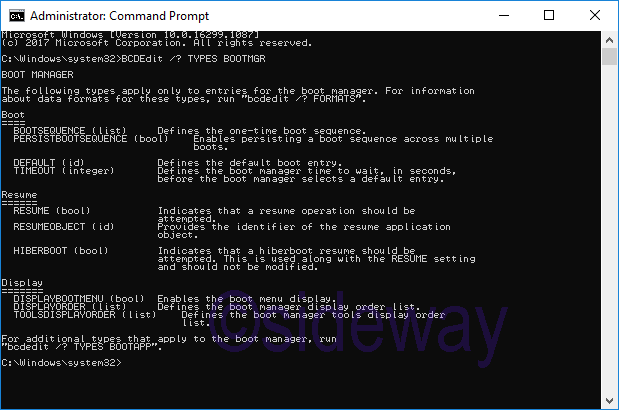 To display the list of types for boot manager
To display the list of types for boot manager
Syntax
bcdedit /? TYPES BOOTMGR
TYPES BOOTMGR
The following types apply only to entries for the boot manager. For information about data formats for these types, run "bcdedit /? FORMATS".Boot
BOOTSEQUENCE (list) Defines the one-time boot sequence. PERSISTBOOTSEQUENCE (bool) Enables persisting a boot sequence across multiple boots. DEFAULT (id) Defines the default boot entry. TIMEOUT (integer) Defines the boot manager time to wait, in seconds, before the boot manager selects a default entry.Resume
RESUME (bool) Indicates that a resume operation should be attempted. RESUMEOBJECT (id) Provides the identifier of the resume application object. HIBERBOOT (bool) Indicates that a hiberboot resume should be attempted. This is used along with the RESUME setting and should not be modified.Display
DISPLAYBOOTMENU (bool) Enables the boot menu display. DISPLAYORDER (list) Defines the boot manager display order list. TOOLSDISPLAYORDER (list) Defines the boot manager tools display order list. For additional types that apply to the boot manager, run "bcdedit /? TYPES BOOTAPP".BCDEdit TYPES BOOTSECTOR
 To display the list of types for boot sector
To display the list of types for boot sector
Syntax
bcdedit /? TYPES BOOTSECTOR
TYPES BOOTSECTOR
Boot Sector type applies to entries that contain bootsector in the form of a file. Currently there are no additional options for this type.BCDEdit TYPES CUSTOMTYPES
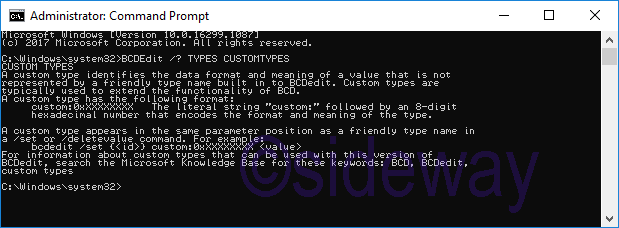 To display the list of types for custom types
To display the list of types for custom types
Syntax
bcdedit /? TYPES CUSTOMTYPES
TYPES CUSTOMTYPES
A custom type identifies the data format and meaning of a value that is not represented by a friendly type name built in to BCDedit. Custom types are typically used to extend the functionality of BCD. A custom type has the following format: custom:0xXXXXXXXX The literal string "custom:" followed by an 8-digit hexadecimal number that encodes the format and meaning of the type. A custom type appears in the same parameter position as a friendly type name in a /set or /deletevalue command. For example:bcdedit /set {<id>} custom:0xXXXXXXXX <value>
For information about custom types that can be used with this version of
BCDedit, search the Microsoft Knowledge Base for these keywords: BCD, BCDedit,
custom types
BCDEdit TYPES FWBOOTMGR
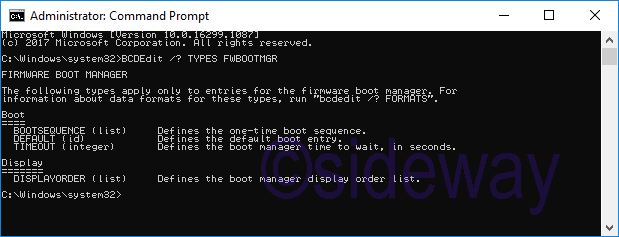 To display the list of types for firmware boot manager
To display the list of types for firmware boot manager
Syntax
bcdedit /? TYPES FWBOOTMGR
TYPES FWBOOTMGR
The following types apply only to entries for the firmware boot manager. For information about data formats for these types, run "bcdedit /? FORMATS".Boot
BOOTSEQUENCE (list) Defines the one-time boot sequence. DEFAULT (id) Defines the default boot entry. TIMEOUT (integer) Defines the boot manager time to wait, in seconds.Display
DISPLAYORDER (list) Defines the boot manager display order list.BCDEdit TYPES MEMDIAG
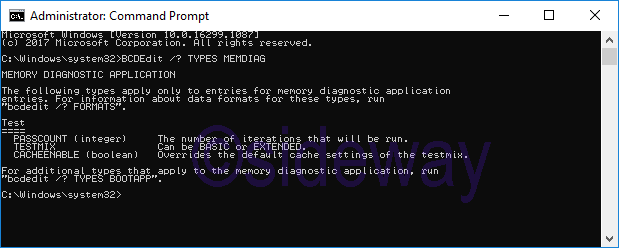 To display the list of types for memory diagnostic application
To display the list of types for memory diagnostic application
Syntax
bcdedit /? TYPES MEMDIAG
TYPES MEMDIAG
The following types apply only to entries for memory diagnostic application entries. For information about data formats for these types, run "bcdedit /? FORMATS".Test
PASSCOUNT (integer) The number of iterations that will be run. TESTMIX Can be BASIC or EXTENDED. CACHEENABLE (boolean) Overrides the default cache settings of the testmix. For additional types that apply to the memory diagnostic application, run "bcdedit /? TYPES BOOTAPP".BCDEdit TYPES NTLDR
 To display the list of types for NTLDR based OS loader
To display the list of types for NTLDR based OS loader
Syntax
bcdedit /? TYPES NTLDR
TYPES NTLDR
Currently there are no additional options for this type.BCDEdit TYPES OSLOADER
 To display the list of types for Windows OS loader
To display the list of types for Windows OS loader
Syntax
bcdedit /? TYPES OSLOADER
TYPES OSLOADER
The following types can be used only for Windows OS Loader entries. For information about data formats for these types, run "bcdedit /? FORMATS".Boot
BOOTLOG (bool) Enables the system initialization log. BOOTSTATUSPOLICY Can be DisplayAllFailures, IgnoreAllFailures, IgnoreShutdownFailures, IgnoreBootFailures, IgnoreCheckpointFailures, DisplayShutdownFailures, DisplayBootFailures, or DisplayCheckpointFailures. LASTKNOWNGOOD (bool) Enables boot to last known good configuration. NOCRASHAUTOREBOOT (bool) Disables automatic restart on crash. RESUMEOBJECT (id) Defines the identifier of the resume object that is associated with this operating system object. SAFEBOOT Can be Minimal, Network or DsRepair SAFEBOOTALTERNATESHELL (bool) Uses the alternate shell when booted into Safe mode. SOS (bool) Displays additional boot information. WINPE (bool) Enables the computer to boot to Windows PE.Display
BOOTUX Defines the graphics experience during boot. Can be Disabled, Basic or Standard. (Defunct.) BOOTMENUPOLICY Defines the type of boot menus the system will use. Can be Legacy or Standard.Options
ADVANCEDOPTIONS (bool) Enables advanced options. LOADOPTIONS (string) Defines any additional options that are not covered by other types. OPTIONSEDIT (bool) Enables the options editor.Processors and APICs
CLUSTERMODEADDRESSING (integer) Defines the maximum number of processors to include in a single Advanced Programmable Interrupt Controller (APIC) cluster. CONFIGFLAGS (integer) Specifies processor-specific configuration flags. MAXPROC (bool) Reports the maximum number of processors in the system. NUMPROC (integer) Uses only the specified number of processors. ONECPU (bool) Forces only the boot CPU to be used. RESTRICTAPICCLUSTER (integer) Defines the largest APIC cluster number to be used by the system. USEPHYSICALDESTINATION (bool) Forces the use of the physical APIC. USELEGACYAPICMODE (bool) Forces the use of legacy APIC mode even if the processors and chipset support extended APIC mode. X2APICPOLICY (integer) Enables the use of extended APIC mode if the processors and chipset support extended APIC mode. Can be Enabled, Disabled or Default. MAXGROUP (bool) Maximizes the number of groups created in group configuration. GROUPAWARE (bool) Forces drivers to be aware of multiple groups in a multi-group environment. GROUPSIZE (integer) Specifies the size of all processor groups. Must be an integer of power of 2.Hardware Abstraction Layer (HAL) & KERNEL
HAL (string) Defines the file name for a private HAL. HALBREAKPOINT (bool) Enables the special hardware abstraction layer (HAL) breakpoint. KERNEL (string) Defines the file name for a private kernel. USEPLATFORMCLOCK (bool) Forces the use of a platform clock source for the system's performance counter. FORCELEGACYPLATFORM(bool) Forces the OS to assume the presence of legacy PC devices like CMOS, keyboard controller etc. TSCSYNCPOLICY Controls the TSC synchronization policy. Can be Default, Legacy or Enhanced.VESA, PCI, VGA, and TPM
USEFIRMWAREPCISETTINGS (bool) Uses BIOS-configured Peripheral Component Interconnect (PCI) resources. MSI Can be Default or ForceDisable. VGA (bool) Forces the use of the VGA display driver. TPMBOOTENTROPY Can be Default, ForceDisable, or ForceEnable.Debugging and Performance
DBGTRANSPORT (string) Defines the file name for a private debugger transport. DEBUG (bool) Enables kernel debugging. PERFMEM (integer) Specifies the size (in megabytes) of the buffer to allocate for performance data logging.Memory
INCREASEUSERVA (integer) Increases the amount of virtual address space that the user-mode processes can use, in MBs. NOLOWMEM (bool) Disables the use of low memory. NX Can be OptIn, OptOut, AlwaysOn or AlwaysOff. PAE Can be Default, ForceEnable, ForceDisable. REMOVEMEMORY (integer) Removes memory, in MBs, from the total available memory that the operating system can use.Drivers and System Root
DRIVERLOADFAILUREPOLICY Can be Fatal or UseErrorControl. EMS (bool) Enables kernel Emergency Management Services. OSDEVICE (device) Defines the device that contains the system root. SYSTEMROOT (string) Defines the path to the system root.Hypervisor
HYPERVISORLAUNCHTYPE Controls the hypervisor launch type. Can be Off or Auto. HYPERVISORDEBUG (bool) Enables hypervisor debugging. HYPERVISORDEBUGTYPE Can be SERIAL, 1394, or NET. HYPERVISORDEBUGPORT (integer) Defines the serial port number for the serial debugger. HYPERVISORBAUDRATE (integer) Defines the baud rate for the serial debugger. HYPERVISORCHANNEL (integer) Defines the channel for the 1394 debugger. HYPERVISORHOSTIP (integer) Defines the IPv4 address of the debugger host for the network debugger. HYPERVISORHOSTPORT (integer) Defines the UDP port to communicate with on the debugger host for the network debugger. HYPERVISORBUSPARAMS (string) Defines the PCI bus, device, and function numbers of the debugging device. For example, 1.5.0 describes the debugging device on bus 1, device 5, function 0. HYPERVISORUSELARGEVTLB (bool) Increases virtual TLB size. HYPERVISORIOMMUPOLICY Controls the hypervisor IOMMU policy. Can be default, enable or disable.Virtual Secure Mode
VSMLAUNCHTYPE Controls the Virtual Secure Mode launch type. Can be Off or Auto.. For additional types that apply to the Windows OS Loader, run "bcdedit /? TYPES BOOTAPP".BCDEdit TYPES RESUME
 To display the list of types for resume loader
To display the list of types for resume loader
Syntax
bcdedit /? TYPES RESUME
TYPES RESUME
The following types apply to entries for the resume loader. For information about data formats for these types, run "bcdedit /? FORMATS".Display
BOOTUX Defines the graphics experience during resume. Can be Disabled, Basic, or Standard. (Defunct.) BOOTMENUPOLICY Defines the type of boot menus the system will use. Can be Legacy or Standard.Hibernation file
FILEDEVICE (Device) Specifies the device containing the hibernation file. FILEPATH (String) Specifies the path of the hibernation file.Other
ASSOCIATEDOSDEVICE (Device) Names the OS device associated with the hibernated OS. This is only useful in cases where the hibernation file is not stored on the OS device. CUSTOMSETTINGS (Boolean) Allows resume loader to use custom settings. PAE (Boolean) Indicates whether the hibernated OS was running with PAE enabled. For additional types that apply to the resume application, run "bcdedit /? TYPES BOOTAPP".Sources and References
- https://docs.microsoft.com/en-us/windows-hardware/drivers/devtest/bcd-boot-options-reference
- https://docs.microsoft.com/en-us/windows-server/administration/windows-commands/bcdedit
- https://docs.microsoft.com/en-us/windows-hardware/manufacture/desktop/bcdedit-command-line-options
- https://docs.microsoft.com/en-us/windows-hardware/drivers/devtest/bcdedit--set
- https://atomicit.ca/kb/articles/how-to-fix-windows-7810-boot-problem-with-bcdedit/
- https://neosmart.net/wiki/bcdedit/#BCDEdit_on_Windows_8
©sideway
ID: 210400010 Last Updated: 4/10/2021 Revision: 0
Latest Updated Links
- Travel Singapore Sight Space(last updated On 12/30/2025)
- Travel Singapore Sight Curiosity Cove(last updated On 12/30/2025)
- Travel Singapore Sight Night Safari(last updated On 12/30/2025)
- Travel Singapore Sight River Wonders(last updated On 12/30/2025)
- Travel Singapore Sight Rainforest Wild ASIA(last updated On 12/30/2025)
- Travel Singapore Sight Singapore Zoo(last updated On 12/30/2025)
- Travel Singapore Sight Mandai(last updated On 12/30/2025)
- Travel Singapore Sight Bird Paradise(last updated On 12/30/2025)
- Travel Singapore Sight AltitudeX(last updated On 12/30/2025)
- Travel Singapore Sight(last updated On 12/6/2025)
- Travel Singapore Rail Network(last updated On 12/5/2025)

 Nu Html Checker
Nu Html Checker  53
53  na
na  na
na
Home 5
Business
Management
HBR 3
Information
Recreation
Hobbies 9
Culture
Chinese 1097
English 339
Travel 31
Reference 79
Hardware 54
Computer
Hardware 259
Software
Application 213
Digitization 37
Latex 52
Manim 205
KB 1
Numeric 19
Programming
Web 289
Unicode 504
HTML 66
CSS 65
SVG 46
ASP.NET 270
OS 431
DeskTop 7
Python 72
Knowledge
Mathematics
Formulas 8
Set 1
Logic 1
Algebra 84
Number Theory 206
Trigonometry 31
Geometry 34
Calculus 67
Engineering
Tables 8
Mechanical
Rigid Bodies
Statics 92
Dynamics 37
Fluid 5
Control
Acoustics 19
Natural Sciences
Matter 1
Electric 27
Biology 1
